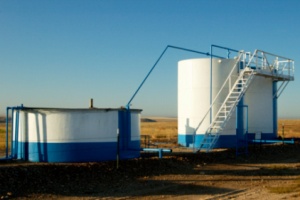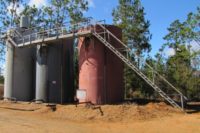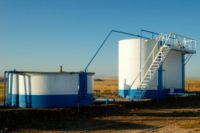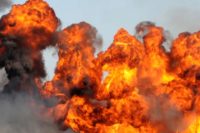CSB calls for tighter security at rural oil, gas sites
Two people seriously injured by explosion in Texas

 A recent incident at a rural oil and gas production site in Texas that critically injured two people has the U.S. Chemical Safety Board (CSB) renewing its call for more precautions – despite the fact that the Railroad Commission of Texas (RRC-TX) has declined to increase security at such sites, arguing that the number of incidents doesn’t justify it.
A recent incident at a rural oil and gas production site in Texas that critically injured two people has the U.S. Chemical Safety Board (CSB) renewing its call for more precautions – despite the fact that the Railroad Commission of Texas (RRC-TX) has declined to increase security at such sites, arguing that the number of incidents doesn’t justify it.
In the most recent accident, near Van, Texas, two 24-year- olds – a man and a woman -- were socializing in the vicinity of an unattended oil and gas production site located in a rural area of Texas when an explosion critically injured both of them.
CSB Chairperson Rafael Moure-Eraso said the board is “deeply concerned” about such accidents, and that states “should take proper precautions to ensure that oil and gas production sites are secured properly, with fencing, gates and warning signs to prevent access by teenagers and young adults who are attracted to the sites as secluded places at which to socialize. ”
A similar accident occurred in 2010 in New London, TX. A 25-year-old man and a 24-year-old woman were on top of an oil tank in an unattended, isolated rural tank site when the tank exploded, killing the woman and seriously injuring the man. This accident followed an incident in Carnes, MS on October 31, 2009, when two teenagers, aged 16 and 18, were killed when a storage tank containing natural gas condensate exploded at a rural gas production site in. Six months later a group of youths were exploring a similar tank site in Weleetka, Oklahoma, when an explosion and fire fatally injured one individual.
The CSB sent investigators to all three sites to collect information on the incidents.
Unaware of the hazards
“The CSB’s investigation into the safety issues at oil and gas sites found that that children and young adults frequently socialize at oil sites in rural areas, unaware of the explosion hazards from storage tanks that contain flammable hydrocarbons like crude oil and natural gas condensate,” said Moure-Eraso. “The unintentional introduction of an ignition source (such as a match, lighter, cigarette, or static electricity) near tank hatches or vents can trigger an internal tank explosion, often launching the tank into the air and killing or injuring people nearby.”
The CSB report identified regulatory gaps at the federal and state levels and called on the U.S. Environmental Protection Agency (EPA) and state regulatory bodies to improve current safety and security measures at exploration and production sites such as warning signs, full fencing, locked gates, locks on tank hatches, and other physical barriers. The report also specifically called on state regulators in Texas to require safer, modern tank designs that reduce the likelihood of an internal tank explosion if an ignition source is inadvertently introduced nearby.
The CSB recommended that the Railroad Commission of Texas (RRC-TX) amend state oil and gas regulations to:
a) Protect storage tanks at exploration and production sites from public access by requiring sufficient security measures, such as full fencing with a locked gate, hatch locks on tank man ways, and barriers securely attached to tank external ladders and stairways.
b) Require hazards signs or placards on or near tanks that identify the fire and explosion hazards using words and symbols recognizable by the general public.
c) Require the use of inherently safer tank design features such as flame arrestors, pressure vacuum vents, floating roofs, vapor recovery systems or an equivalent alternative, to preventthe ignition of a flammable atmosphere inside the tank.
Texas: No need for new safety measures
In April 2012, the RRC-TX formally responded to the CSB recommendation by declining to impose new security and design measures for oil tank storage sites. The commission formally declined to impose new security and design measures for oil tank storage sites arguing that the number of incidents identified by the CSB did not demonstrate a need for new safety measures.
"The CSB will continue to follow up on this accident but at this time I would like to once again calling on the Railroad Commission of Texas to reexamine the CSB’s recommendation and take the proper action to prevent future accidents similar sites throughout the state,” said Moure-Eraso. “It is my view that regulatory requirements should be based on potential risks – in this case the risks are quite obvious – from 1983 to 2010 there were 26 similar incidents resulting in 44 fatalities and 25 injuries of members of the public under the age of 25. Alarmingly, the CSB study found 27% of the 26 incidents occurred in Texas and Oklahoma respectively.
“It is interesting to note that the CSB’s investigation found a few major cities and some states, such as California and Ohio, already require varying levels of security for oil and gas production sites, such as fencing, locked or sealed tank hatches, and warning signs. As a result, California did not appear to have any fatal tank explosions between 1983 and 2011. However, many other large oil and gas producing states have no such requirements. The major oil producing states Texas and Oklahoma require fencing and warning signs for certain sites that have toxic gas hazards but not for all sites with flammable storage tanks.”
Click here to visit the Investigation Information page.
About the CSB
The CSB is an independent federal agency charged with investigating serious chemical accidents. The agency's board members are appointed by the president and confirmed by the Senate. CSB investigations look into all aspects of chemical accidents, including physical causes such as equipment failure as well as inadequacies in regulations, industry standards, and safety management systems
The Board does not issue citations or fines but does make safety recommendations to plants, industry organizations, labor groups, and regulatory agencies such as OSHA and EPA. Visit our website, www.csb.gov.
Looking for a reprint of this article?
From high-res PDFs to custom plaques, order your copy today!






